48th Surgical / 128th Evacuation Hospital Unit History
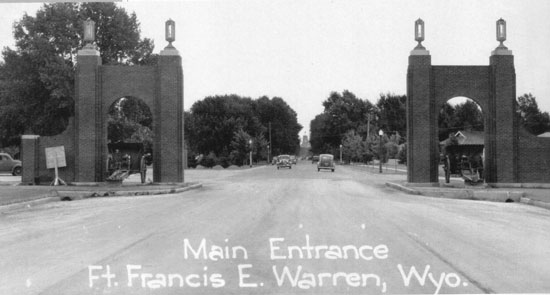
Illustration showing the main entrance to Fort Francis E. Warren, located at Cheyenne, Wyoming – location of the 48th Surgical Hospital’s activation.
Activation & Training
1 July 1923 – Surgical Hospital No. 48 is constituted, and allotted to the Organized Reserve. It is assigned to the Sixth Corps Area Command by Table “A”, Tables of Troops pertaining to Appendix G-3, ref. WDGMP, Jul 23.
23 March 1933 – Surgical Hospital No. 48 is re-designated 48th Surgical Hospital, ref. GO No. 5.
1 October 1933 – The 48th Surgical Hospital is withdrawn from the Organized Reserve, and allotted to the Regular Army, effective 1 Oct 33, ref. AG 320.2 ( 16 Aug 33), 18 Aug 33.
10 February 1941 – Assigned to Fourth United States Army, and activated at Ft. Francis E. Warren, Cheyenne, Wyoming (ASFTC, acreage 94,874, troop capacity 665 Officers & 16,518 Enlisted Men –ed), ref. AG 320.2 (15 Nov 40) M (Ret) M-C, 16 Dec 40, AG 320.2 (7 Jan 41) M (Ret) M-C, 13 Jun 41, AG 320.2 (25 Apr 41) M (Ret) M-C, 25 Apr 41, and activated, ref. GO No. 4, at Ft. Francis E. Warren, Wyoming, ZI, 10 Feb 41. The unit was comprised of approximately 300 personnel, and was a non-affiliated organization. The Nurses were all volunteers from various areas of the United States with about 20% coming from Ft. Knox, Louisville, Kentucky (Armored Replacement Training Center & School –ed). Medical Officers were mostly Doctors with a few extra logistic and administrative personnel, while the Enlisted Men were draftees or volunteers.
18 February 1941 – The 48th Surgical Hospital is relieved from Fourth United States Army and assigned to V Army Corps upon arrival at its new station in New York State, New Jersey and Pennsylvania Area, ref. AG 302.2 (14 Feb 42) MR-M-C, 18 Feb 42.
12 May 1942 – It is relieved from V Army Corps and assigned to Second United States Army, Ltr, ref. AGF, 320.2/101 (C) GNOPN, (12 May 42), 1 May 42. Rescinded by Ltr, ref. AGF, 320.2/101 (C) GNOPN, 12 May 42.
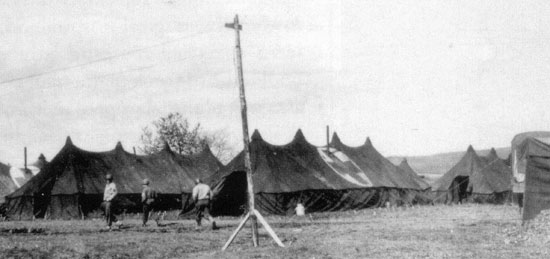
Photograph showing a tented hospital established by the 48th Surgical Hospital during its time at Ft. Warren.
25 July 1942 – The Hospital is then transferred for a permanent change of station from Ft. Francis E. Warren, Wyoming, to New York POE (Staging Area: Indiantown Gap Military Reservation, Pennsylvania –ed) enroute to England, Shipment No. 9190-P, ref. AG 370.5, (24 Jul 42) MS-E-M, 25 Jul 1942.
30 July 1942 – The Hospital departed arriving at Indiantown Gap on 2 August 1942.
On 1 August 1942, 39 Nurses under command of Lt. Alys Salter and 75 Enlisted Men arrived for duty with the 48th Surgical Hospital at Indiantown Gap Military Reservation, Pennsylvania, Zone of Interior.
The 48th Surgical and 128th Evacuation Hospitals are one and the same unit. The 48th Surgical Hospital, a 400-bed medical unit arrived in the MTO Theater on 8 Nov 42 and served in Algeria and Tunisia. Campaign credits include Algeria, French-Morocco, and Tunisia. On 1 May 1943, the unit was reorganized and re-designated the 128th Evacuation Hospital, Semimobile, still a 400-bed Hospital which continued to serve in Tunisia and Sicily, until it got transferred to the ETO on 26 November 1943. Additional Campaign credits were obtained including Sicily, Normandy, Northern France, Rhineland, Ardennes-Alsace, and Central Europe.
Overseas Movement & Arrival in the United Kingdom:
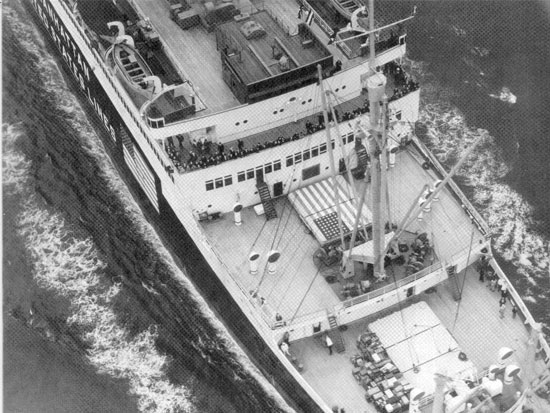
The USS “Wakefield” which transported the main body of the 48th Surgical Hospital to Scotland. It was originally named the Manhattan and was built in 1932 as a trans-Atlantic liner.
Departure took place on 5 August, and on 7 August 1942 the Nurses of the 48th Surg Hosp left the United States aboard the USS “Wakefield”, sailing from New York POE as part of one of the largest convoys ever to cross the Atlantic. The 60 Nurses met their Commanding Officer, Colonel Merritt G. Ringer aboard the ship which would end her journey in Glasgow, Scotland, by way of Halifax, Nova Scotia, Canada. The Hospital disembarked at Greenock, Scotland, on 18 August 1942, and then entrained for a one-day ride to southern England (reaching London on 20 August). At this point the Hospital unit was made up of the following numbers:
22 Medical Officers – 1 Chaplain – 60 Nurses – 250 Enlisted personnel
As a Surgical Hospital, the 48th consisted of a Headquarters and three subordinate elements – 2 Hospitalization Units with a 200-bed capacity each, that could be established independently at one or more points according to field requirements, and 1 Mobile Surgical Unit, entirely mobile and self-contained (which would always be with the most forward of the two units), that could operate for any of the Hospitalization Units, or for supplementing the surgical facilities of any Army Evacuation Hospital on a temporary basis. Subunits of the Hospitalization Units were a Headquarters Section, a Technical Section, and 2 Ward Sections (100-patients capacity). As per T/O 8-570, dated 1 April 1942, personnel figures amounted to 50 Commissioned Officers, 60 Nurses, and 275 Enlisted Men, an aggregate of 385. Vehicles included 2 x ¾-Ton Ambulances, 2 x ¾-Ton Weapon Carriers Trucks, 3 x ¾-Ton Carryall Trucks, 4 x ¾-Ton Command & Reconnaissance Trucks, 1 x 2 ½-Ton 700-Gallon Water Tank Truck, 10 x 2 ½-Ton Cargo Trucks, 4 x 1-Ton 2-Wheel 250-Gallon Water Trailers.
The Mobile Surgical Unit were supported by extra personnel (Teams) pertaining to the 2d Auxiliary Surgical Group (authorized at the rate of one per Army in the field); they were available to move from hospital to hospital wherever their services were needed, and were therefore used to augment the personnel of Surgical and Evacuation Hospitals. A total of 6 Teams were to be attached to the 48th.
Personnel of the 48th Surgical Hospital
August – September 1942 (incomplete list)
Nurses:
| Archard, Theresa | Hale, Allison | Miller, Violet |
| Atkins, Edna | Hall, Ursula | Molony, Helen M. |
| Ayers, Ginny | Hamaker, Mary | Nichols, Beatrice E. |
| Becke, Ann | Harris, Mildred H. | Nickerson, Emily |
| Boden, Leola M. | Hart, Margaret | Nickles, Amy L. |
| Boyd, Ann | Haskell, Ruth | Parker, Edna M. |
| Bringham, Amy | Hatcher, Mary | Parks, Rutgh |
| Brittingham, Doris | Helm, Kathlyn | Perkins, Willye M. |
| Browning, Edna Marie | Hilton, Esther | Pettingill, Janet |
| Burke, Emily V. | Hobson, Helen W. | Pridham, Dorothy |
| Cameron, Martha | Hodges, Edith M. | Purnell, Carrie E. |
| Carl, Maude M. | Hodges, Evelyn | Rickman, Marie H. |
| Coates, Elizabeth G. | Hornback, Margaret R. | Rinehart, Elma L. |
| Cooney, Annie | Howard Lula J. | Rogers, Kate |
| Coty, Emma I. | Johnson, Verta J. | Romohr, Gladys |
| Cox, Dorothy | Kahle, Maybelle | Sacks, Eva |
| Cunningham, Catherine | Kaelin, Mildred H. | Self, Gladys |
| Davidson, Gertrude | Karban, Beryl | Sheridan, Vivian |
| Devine, Rosemary | Kavanaugh, Billie | Smith, Carie |
| Dickie, Aldra | Kelly, Marie | Spears, Lois A. |
| Dorton, Maribel E. | Kemer, Evelyn | Sramcik, Margaret |
| Ducibella, Crolyn T. | Kenny, Margaret F. | Standley, Hazel C. |
| Duer, Agatha | Kirkwood, Doris | Stanfill, Margaret B. |
| English, Helen M. | Knight, Kathleen | Sullivan, Mary Ann |
| Farbough, Frances | Kruzic, Genevieve F. | Swaney, Edith M. |
| Ferree, Ella J. | Kunst, Margaret | Taylor, Kathryn R. |
| Fisher, Evelyn Vaughn | Leible, Hilda | Thompson, Julia D. |
| Flippo, Helen C. | Littlefield, Edith F. | Tonzes, Berneice A. |
| Forbes, Thelma B. | MacDonald, Phyllis | Tyler, Eunice C. |
| Francis, Mary E. | MacKay, Margaret | Vogler, Vilma E. |
| French, Evelyn | Madigan, Margaret | Wheeler, Ruth E. |
| Friedlund, Doris H. | Martin, Gladys | Wheeler, Sarah P. |
| Gecke, Annie G. | Martin, Maureen J. | White, Ora |
| Gerhard, Dorothy E. | McNeive, Rosemary | Williams, Nell |
| Greene, Betty J. | Meyers, Mary | Willis, Luella |
| Grier, Etoyl | Miller, Agnes | Zimmerman, Marieta |
| Grimes, Florence M. | Miller, Margaret |
Chaplains:
| Arsenault, Frank (Chaplain’s Assistant) | Grove, Samuel A.C. “Chappie” | Father Paniera |
| Power, John J. |
Officers:
| Bogardus, George (1st Lt) | Hartigan, John P. | Rifkin, Samuel (Capt) |
| Borgmeyer, Henry J. (Capt) | Katzovitz, Hyman (Capt) | Ringer, Merrit G. (Col > CO 1942) |
| Burgess, Thomas W. | Kavitt, Henry | Rohlf, Ed L. (Capt) |
| Burton, Frank M. (Maj) | King, Richard S. (Capt) | Rosenbaum, Edward E. (Maj) |
| Carney, Art (Capt) | Kingston, Louis C. (Capt) | Rosencrans, Harold S. (Capt) |
| Clark, Richard H. (Maj) | Klein, Vincent (2d Lt) | Rutledge, Samuel H. Jr. (Capt) |
| Connelly, Harry J. (Capt) | Klockseim, Harold | Salter, A. L. (Lt Col) |
| DeVito, Michael P. (Capt) | LeeRoy, Arthur (Capt) | Schwade, Leonard, J. (Capt) |
| Dooken, Thomas N. (WOJG) | Leimbac, John H. (Capt) | Shiffler, Harry K. (Capt) |
| Duffy, Frank K. (Capt) | Mackenbrock, Frederick C. (Maj) | Snyder, John M. (Lt Col) |
| Ebbert, Charles A. (Capt) | Mansfield, Max R (Capt) | Solomon, David (Capt) |
| Fast, John G. (Capt) | Marmer, Milton J. | Stappenbeck, Richard |
| Findley, James W. (Capt) | McDonald, George J. (Capt) | Sutton, Bruce B. (Capt) |
| Flynn, John J. (1st Lt) | McIntosh, Russell B. | Tello, Rocko |
| Ford, John M. Jr. (2d Lt) | McShatko, George G. (Lt Col) | Tropea, Frank Jr. (Capt) |
| Forman, Louis H. (Capt) | Meier, Rupert Jr. (2d Lt) | Wahl, Robert H. (Capt) |
| Geist, Frederick D. (Capt) | Meillies, Chester A. | Weinberger, Howard |
| Gingles, Charles H. (Col) | Moore, Ray J. (1st Lt) | Weisel, Wilson |
| Gordon, John H. (Capt) | Peake, Ben (Col) | Wheeler, William H. (Capt) |
| Gorishek William M. | Predovitch, Milan | Wiley, Norman H. (Col > CO 1944) |
| Grabau, Ellis V. | Proffitt, William E. Sr. (Lt Col) | |
| Harris, Marshall | Rainey, Harry C. (Maj) |
Enlisted Men:
| Aasheim, Oscar E. | Hartman, Robert D. | Pewitt, Robert |
| Adamek, James | Hartmann, Joseph N. | Pigoni, Wino |
| Albright, Delbert | Hartson, Clifford C. | Platt, Harold W. |
| Alwine, Francis | Harwell, Earl | Popeck, Jr., Robert |
| Anawausch, Howard P. | Harwell, Hilliard E. | Power, Allen R. |
| Arbeith, Joseph | Heinke, John P. | Rascop, Felix H. |
| Arnold, Lee W. | Helle, Arnold F. | Rasmussen, Floyd T. |
| August, Maurice | Herbolsheimer, Gerhardt | Reinier, Hugh W. |
| Bair, Cecile “Teddy” | Hetland, Henry L. | Renninger, George F. |
| Baker, Melvin H. | Hoctor, John A. | Rhoades, Dixon E. |
| Bakken, Lionel S. | Hogan, Ray | Riesenberg, Paul A. |
| Banitt, Myles W. | Holeck, Fred H. | Ritter, D. R. |
| Baumhardt, V. E. | Hourican, Donald | Roberts, Wiley L. |
| Baxa, Leonard J. | Howe, George R. | Rollins, Willaim R. |
| Beckman, Walter J. | Hudson, Harold J. | Rourk, Alva C. |
| Bellanger, Benjamin | Huelsman, Lester J. | Rousu, Ruben A. |
| Bellcourt, Paul L. | Hughes, Lonnie N. | Ruddy, E. J. |
| Bellrichard, Howard H. | Hurley, Burton F. | Ryan, Ernest J. |
| Benson, Clarence E. | Inderrieden, Lawrence | Sagan, Julian W. |
| Bernhardt, Rubin | James, Joseph F. | Salisbury, Elmer G. |
| Beyers, Shorty | Jenkins, Dolcie | Salmon, Arnold L. |
| Bissen, Raymond J. | Jensen, Raymond H. | Sampson, Lawrence |
| Blackburn, Theodore | Jerdet, R. L. | Sanders, Harm D. |
| Blanchard, Thomas E. | Johnson, Elmer C. | Sanders, Willard |
| Bohman, Alex J. | Jones, Leslie A. | Sapienza, Rocco |
| Boock, William A. | Justice, Graham | Scannel, Raymond |
| Boswell, Robert | Kalb, Clifford J. | Scheiber, Frederick H. |
| Breuer, Julies R. | Katzen, Murray | Schmitt, Joseph |
| Brewer, Aaron | Kaufmann, Edward A. | Schulz, Harold F. |
| Brizzolara, George | Kelly, Edward T. | Shanks, Hunter W. |
| Brookman, Hunter | Kelly, John | Silva, Torivio |
| Brown, Bertle J. | Kessler, George W. | Silverberg, Maurice A. |
| Bryngleson, Leslie D. | Keyes, Joseph P. | Simion, Frank A. |
| Budziak, Alex J. | Kircher, Theodore | Skiver, Herman L. |
| Burrack, Alvin W. | Klinsing, Raymond | Smith, Delmer I. |
| Bursey, John A. | Knott, Elton H. | Smith, Edward J. |
| Butts, Loren E. | Koloen, Wilbur B. | Smith, George |
| Calcaterra, Mario | Kopan, Christ T. | Smith, Gilbert, |
| Cantu, Edward R. | Krist, Frank J. | Smith, John |
| Carter, Deloy O. | Krokos, Louis E. | Sorlie, Arnum L. |
| Catania, Anthony | Kruger, Robert E. | Sorlye, Oliver A. |
| Cetola, Jospeh P. | Kubert, Frank | Steinmetz, John E. |
| Chadwick, Kenneth H. | Kuhl, Don | Stephens, Frank E. |
| Chalfant, James R. | Kukowski, Frank W. | Stephenson, Russell |
| Chapa, Joe | Kuyper, Glen | Stevenson, Paul W. |
| Chinn, Donald | Lail, Paul | Stone, James O. |
| Clausen, Arlid | Lakes, George A. | Stratton, Harold H. |
| Cloud, L. F. | Lanning, Max L. | Straub, Paul R. |
| Cohen, Ben F. | Lansing, Thomas | Strode, J. R. |
| Cohen, Jerome | Larson, Walter F. | Stubbs, Howard W. |
| Conner, Dexter | LaRoque, Jean F. | Sturdevant, Richard H. |
| Corondao, Francisco J. | Laurenson, Clarence W. | Sundby, Karnes |
| Craig, Robert F. | La Varnway, Jack | Surmeyer, Orville J. |
| Czuyper, John | Lentz, Harley U. | Sutton, Ralph E. |
| D’Aloia, Peter | Leudecke, Hilton | Svec, James |
| Daniele, Joseph | Lucchese, Tony | Swan, Wesley |
| Darsie, James C. | Malecha, Joseph A. | Swanson, Jack |
| Dauzat, Robert | Malfa, Sol A. | Swezey, John P. |
| Davidson, Kenneth | Malfa, Vincent | Tall, Vernon |
| Davidson, Roy G. | Mapes, Albert E. “Shorty” | Tarr, Oliver W. |
| Davis, Al | Marshbanks, James | Taylor, Edward |
| Dennis, John E. “Jack” | Mathistad, John | Taylor, Gerald C. |
| Diamond, Charles S. | Matthews, Jay W. | Taylor, R. T. |
| Dick, James | McBride, Robert W. | Thoeny, Ralph H. |
| Dickie, Aldra | McCafferty, John J. | Thomas, Leonard |
| Dirkson, Henry | McCullough, Earl L. | Thorson, Charles |
| Doolin, Alfred E. | McGinley, Robert S. | Tisler, Joseph |
| Doughlas, Joseph | McHenry, James P. | Toschi, Aldo |
| Drime, Joseph A. | Meinders, Marvin H. | Treece, Thomas J. |
| Drost, Maynard | Meinen, Otmer M. | Urbanski, Joseph L. |
| Duensing, Francis E. | Meyers, Joseph C. | Van Delinder, Scott |
| Dunbar, Elmer J. | Michel, Arnold A. | Van Woert Dwight E. |
| Duxbury, Marcus W. | Miller, Mark B. | Veres, Charles J. |
| Duzat, Robert | Moll, Garnet E. | Wagner, Robert L. |
| Eden, William G. | Morgan, George | Wain, Albert E. |
| Fagerlund, Maurice W. | Morgan, John | Waller, James A. |
| Farnham, Robert W. | Mudge, James P. | Warner, Wilfred E. |
| Felcyn, Roman D. | Murphy, George R. | Watson, William |
| Flaugh, Marvin O. | Murphy, James E. | Weathers, B. P. |
| Gacke, Walter W. | Murphy, Owen B. | Weaver, James A. |
| Glade, Gerald E. | Murphy, Sayler B. | Weber, Clarence F. |
| Gold, Ormie | Nath, Raumond B. | Weber, Leo D. |
| Goodman, George “Goody” | Nefstead Raymond B. | Weiss, Leon |
| Gray, Lester A. | Nelson, Leo F. | Wertz, Donald |
| Gregory, Michael L. | Noland, George S. | West, Woodrow W. |
| Gregory, Michael P. | Nowakowski, Mitchell | Whitman, James |
| Griebel, Alvin C. “Fritz” | Ochocki, Stanley S. | Wildman, James D. |
| Groves, Joseph Everett | Olson, Melfred J. | Willett, George |
| Gunderman, Clarence L. | Oppek, Florian J. | Willis, Kenneth E. |
| Gustafson, Ervin J. | Pagano, Samuel | Winzeler, Edwin C. |
| Hagan, Gordon J. | Pagoria, Joseph | Wood, Walter S. |
| Halverson, Maurice E. | Pappas, Paul C. | Woodruff, Melvin S. |
| Hamm, William E. | Patton, John W. | Woodyard, Marion M. |
| Hanson, Donald M. | Paustis, Edward E. | Zeichner, Edward |
| Harden, Robert L. | Payan, Jose E. | Zetterlund, Lawrence |
| Harmon, Jodie D. | Peterson, Stanley | Zlataritz, Felix |
| Harms, Wilbur C. | Peterson, Theodore C. |
While in Tidworth, southeast Wiltshire (at the edge of Salisbury Plain) where the unit would remain for almost 2 ½ months, the days were spent marching, drilling and guarding, until they moved up into the mountains outside of Glasgow to begin a whole new regimen of field living and training. Unit training encompassed a program during which each of the three units trained as an independent unit, with individual and group training correlated in the establishment and operation of that specific portion of the Hospital for which each unit was responsible. Training the entire hospital followed, with extensive loading, unloading, packing and unpacking of equipment, setup and simulated operation of the Surgical Hospital. The latter training was vital for the future efficiency of the organization. The Hospital was housed in hard brick buildings, the British Army “Tidworth Barracks”, where many an American unit would be stationed prior to the Invasion of Normandy.

Members of the Army Nurse Corps belonging to the 128th Evacuation Hospital march out of the gatehouse at Tidworth on 6 June 1944.
The 48th Surg Hosp had moved overseas within the frame of “Bolero”, the huge troop build-up planned with the aim to launch attacks against Europe and North Africa in order to relieve pressure on the Russians. By the end of 1942, 4 US Army General Hospitals (2d Gen Hosp, 30th Gen Hosp, 67th Gen Hosp, 298th Gen Hosp), 4 Station Hospitals (3d Sta Hosp, 10th Sta Hosp, 38th Sta Hosp, 152d Sta Hosp), and 1 Evacuation Hospital (2d Evac Hosp) were in operation under USAFBI.
First Operations in North Africa:
On 20 October, the Hospital returned to Greenock, Scotland. On 23 October 1942, the unit sailed from the British Isles to North Africa. The 48th Surgical Hospital had been selected to provide medical personnel for the “Roosevelt Group” which was to participate in “Operation Torch”, the Invasion of North Africa (8 November 1942). This landing operation was a joint assault by American and British forces to liberate North Africa from enemy forces. This select personnel from the 48th consisted of 6 Officers, 6 Nurses, and 20 Enlisted men. The group embarked for North Africa together with the 26th Infantry Regiment, 1st Infantry Division (one of the oldest US Army Divisions) and Brigadier General Teddy Roosevelt Jr. (Theodore Roosevelt’s son), which formed Combat Team 26. HMS “Orbita”, HMS “Monarch of Bermuda”, and USAT “Santa Paula” part of the Center Task Force convoy, were the ships that carried the 48th Surgical Hospital during “Operation Torch” to the shores of North Africa (Algeria) on November 8, 1942. The total 48th medical complement consisted of 48 Officers, 57 Nurses, and 273 Enlisted Men.
The Center Task Force was to carry two US Hospitals in the assault, the 400-bed 48th Surgical Hospital and the 750-bed 38th Evacuation Hospital, with another 750-bed unit, the 77th Evacuation Hospital, scheduled for a second convoy to reach Oran on D + 3, along with the 51st Medical Battalion.
The “Roosevelt Group” on the “Monarch of Bermuda” landed 15 miles west of Oran, near the village Les Andalouses, with 1 Collecting Company and 1 Clearing Platoon from the 26th RCT. The “Allen Group” aboard the “Orbita” carrying full third echelon support of the 48th Surg Hosp, was accompanied by 2 Collecting Companies and 2 Clearing Platoons needed to provide medical care to the 16th and 18th RCTs. Both groups landed simultaneously east of Oran at Arzew, on D-Day, 8 November 1942. 30,000 American soldiers of the Center Task Force, along with the Doctors, Nurses and Enlisted Men of the 48th Surgical Hospital disembarked from landing craft for the first amphibious landing of American troops in North Africa. These troops (Nurses included) landed under artillery fire from the French Garrison on the shores. The remainder of the 48th Surg Hosp came ashore in landing craft during the afternoon of D-Day, but without equipment and scattered over a 2-mile area. Arzew was already secured at 0300 hours.

Nurses of the 48th Surg Hosp marching from the Arzew docks to join the remainder of their unit, 9 November 1942.
After consolidation, 3 Surgeons and 3 Nurses of the Second Unit were detached to the Arzew Civilian Hospital in hands of the 1st Medical Battalion (1st Infantry Division). The detachment was augmented during the night by 4 operating teams of 2 Surgeons and 1 Nurse each. They worked together throughout the night of 8-9 November by flashlight, and as there were not enough beds for all casualties, wounded soldiers just lay on the concrete floor. The First Unit along with the Mobile Surgical Unit set up operations in nearby French military barracks on 10 November, taking over operation of the Civilian Hospital at the same time. Equipment and supplies were borrowed from the British Navy, US Army units in the area, the French Army, and the 38th Evacuation Hospital (not yet operational), until its own equipment was brought ashore on 13 November. Among medical supplies borrowed from the 38th Evac Hosp were 480 Plasma units and 100 Morphine Syrettes. By December, the 38th Evacuation Hospital, having collected the bulk of its equipment, was operating under tentage at Oran. The 51st Medical Battalion which had arrived on D+3, became responsible for setting up a Medical Supply Depot after one of its a detachments had distributed the necessary medical supplies to the beachhead troops. The most serious problem related to medical supply during the early stages of the Center Task Force’s operation was the lack of proper communication among medical supply personnel. There was also a critical shortage of drugs, surgical instruments, dental supplies, and hospital field items, leading to a distribution system based on priorities. The consequence was that medical personnel did not have in their possession sufficient medical equipment to permit their proper functioning upon landing. To provide an initial supply dump (for future amphibious operations), it was suggested that each ‘medic’ be issued an additional haversack or musette bag containing vitally essential medical supplies, such as dressings – field instruments – drugs – and blood … it was further recommended that medical maintenance units be packed in 100-pound waterproof boxes, designed for hand carrying during landings.
The maximum number of patients treated at any one time was 480 including American, British, French and locals. Evacuation from Center and Eastern Task Forces was by British Hospital Ship to England. The 48th Surgical Hospital continued treating casualties under sporadic sniper fire. When the hostilities ended the unit functioned as a Station Hospital until 14 January 1943.
The 48th Surg Hosp operated as a Station Hospital in Arzew (Oran area) from 9 November 1942 to 18 January 1943, when it was relieved by the 40th Station Hospital (which would remain on site until 4 March 1943).
The unit left Arzew, eastbound towards Constantine on 18 January 1943. It moved 400 miles over a period of two days. The First Unit set up near Thala (north of Kasserine), Tunisia on 27 January. The Second Unit with its Mobile Surgical Unit was stationed at Fériana (southwest of Kasserine), Tunisia, in an old outpost barracks, recently vacated by the Germans. Both units were located more than 50 miles from the frontlines. On 1 February the First Unit (under Lt. Alys Salter) shut down and joined the Second, then the entire unit was ordered back to Thala, where all Units opened again on 10 February 1943.
During the night of 14-15 February, the Second Unit (under Lt. Theresa Archard) with the MSU (Mobile Surgical Unit) was ordered to evacuate on 15 February because of the German counter-offensive at Kasserine Pass. They left Fériana and moved to Bou Chebka, but before they could receive casualties they were forced to move further back to Youks-les-Bains (west of Tébessa) in Algeria. This was 17 February. When weather conditions made air evacuation impossible, a section of the British 6th Motor Ambulance Company (25 ambulances + 2 buses) was rushed to Youks-les-Bains, where it was placed at the disposal of the 48th. Together, they succeeded in moving 180 patients and clearing Tébessa by the time the enemy broke through Kasserine Pass. The First Unit in Thala, was meanwhile also evacuated. It took them 4 ½ hours to dismantle, pack, evacuate, and move its 200-bed section!
The First Unit then moved forward to La Meskiana, Algeria two days later (together with the 77th Evacuation Hospital), and the Second Unit went to Montesquieu, Algeria. This was the current situation on 24 February 1943. After withdrawal from Kasserine Pass, II Corps resumed the offensive, and by 19 March, the 48th Surg Hosp was back in Tunisia. The First Unit in Fériana, with the 9th Evacuation Hospital taking over at Youks-les-Bains, while the Second Unit was ordered to Gafsa to set up on 17 March 1943. At this time the 48th Surgical Hospital was barely 12 miles behind the frontlines at El Guettar, Tunisia. The Chief Nurse of the 48th Surgical Hospital near Gafsa remembered that the medical installation was situated between an ammo dump and an airfield, both of which were primary targets for enemy bombers. The danger of the situation served to pull Doctors and Nurses together into a team based on mutual respect. Some MC Officers and medics believed that employing female personnel such as Nurses so near to the frontlines would prove troublesome, but the work of the Army Nurses, their dedication, and their professionalism more than proved their worth in the North African campaign. On this third day of battle, 416 wounded men came through admissions in the night till early morning, of who 86 required emergency operations. To meet the immediate need for whole blood, the unit set up an informal Blood Bank at its Gafsa section, where 25 to 50 troops were detailed each day as donors. Shortly after this campaign, War Correspondent Ernie Pyle wrote an article about the 48th and on 19 April the Hospital set up for the last time. On 22 April, the 11th Evacuation Hospital relieved the 48th Surgical which closed for reorganization.
Effective, 1 May 1943 (GO No. 34, II Corps), the 48th Surgical Hospital was converted and redesignated the 400-bed 128th Evacuation Hospital, Semimobile under T/O & E 8-581, and assigned to II Army Corps (ref. AG 320.2 (24 Apr 43) OB-I-SPMOU-M, 26 Apr 43).
On 4 May 4 the Hospital returned to combat duty southwest of Mateur. It then moved to Sidi Nisir near Hill 609, where a bloody battle was fought. In the battles of El Guettar and Maknassy (southern Tunisia) between 20 to 34 psychiatric cases were reported. Special treatment was established and this new ‘problem’ thoroughly investigated, and when properly treated, 30% of all psychiatric cases could return to full duty within thirty hours. Additional Division Surgeons and Psychiatrists were henceforth attached to the 128th Evac Hosp in the forward areas for initial treatment of such ‘new’ cases. On 8 May, fighting stopped in Tunisia with the last Axis troops surrendering on 11 May 1943. The Hospital then moved to Lac Bizerte on 13 June.
Operations in Sicily:
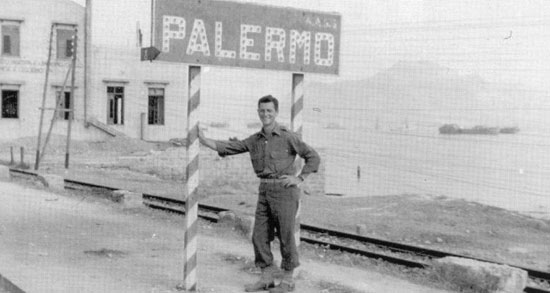
Captain Leonard Schwade of the 128th Evacuation Hospital standing in front of a sign located at the entrance to Palermo.
With Patton’s Seventh United States Army moving out to Sicily 9 July 1943 for “Operation Husky”, the 128th Evacuation Hospital was included for medical support. Plans for medical personnel put emphasis on mobility and shortening of evacuation lines, and medical units under Corps and Army control were reorganized. Attached medical troops were to land with unit equipment, augmented by special items such as blood plasma – morphine – and extra field dressings. Supplies not handcarried by the debarking medical personnel were to be unloaded on the beaches as quickly as possible. Each Division was to be supported by a 400-bed Evacuation Hospital. Evacuation from the beaches was to be by Troop Carrier or Landing Ship Tank, since air evacuation was only possible after capture of suitable airfields. The 400-bed Evacuation Hospitals were not part of the initial assault (Field Hospitals were).
The first group of personnel from the 128th Evacuation Hospital landed at Licata, Sicily, on 22 July 1943. The remainder of the personnel landed on 30 July, opening at Cefalu on 31 July, after collecting its scattered equipment and men. This was the area (left flank of the US sector) where “Joss Force” went ashore comprising the 3d Infantry Division, a Ranger Battalion, and a Combat Command of the 2d Armored Division. Following the assault against nominal opposition, Licata fell quickly, and strong patrols pushed inland on D-Day. The necessary medical support followed and within a few days, was fully and efficiently handled by hospital units, such as the 10th and 11th Field Hospitals and the 11th Evacuation Hospital.

View of a roadway running through the tented hospital complex maintained by the 128th Evacuation Hospital.
Due to the rapid Allied advance, units often leapfrogged one another and continuously shifted to new locations. On 5 August, the 128th was still at Cefalu; on 14 August, it displaced half its facilities eastward, from Cefalu to Coronia (8 miles east of San Stefano). Between 19 August and 31 October 1943, the Hospital in fact operated as a Station Hospital, established at Castellammare-Alcamo.
On October 2, 1943 a heavy storm struck the 128th Evac Hosp. Within five minutes every tent had been torn or leveled. Tent poles, Laboratory equipment, X-Ray equipment were broken with 195 patients on the wards. Personnel worked fervently to move the Hospital into buildings in a nearby town, Alcamo.
Malaria cases started to outnumber battle wounds, and the 128th saw increasing numbers of patients being brought in with malaria. Nurses lined the tents with mosquito netting, but eventually also succumbed. Patient turnover was high, and some days the Hospital would admit 300 patients in a 24-hour period, and evacuate another 200 to North Africa for further treatment. Soon after the capture of Palermo, that city became the focal point for medical evacuation to North Africa. A captured Italian Hospital Train, staffed by US medical personnel, ran between Cefalu and Palermo. Although the Sicilian Campaign was over by 17 August, the 128th remained in Palermo until 7 November 1943.

Aftermath of the heavy storm which struck the 128th Evac Hosp, and damaged a number of the tents.
November 8, 1943 marked the one year Anniversary of the unit’s entry into combat. They had received and treated 21,305 casualties, 2,586 of them requiring surgery and it was on this date that they left Sicily as the most experienced Hospital in the U.S. Army. Next stop was England, to train the new and inexperienced Hospital units for the planned Invasion of France.
Just for the record: the 128th Evacuation Hospital, Semimobile, was transferred from the North African Theater of Operations (NATO) to the European Theater of Operations (ETO), and assigned Shipment No. 62016-H, ref. AG 370.5 (25 Jun 43), OB-S-SPMOT-E-M, 30 Jun 43, by Ltr, NATO, dated 8 Oct 43. Upon arrival at destination, the 128th Evac Hosp was relieved from assignment to the North African Theater of Operations, and assigned to the European Theater of Operations, ref. AG 322 (19 Nov 43) OB-I-E-M, dated 20 Nov 43. It was re-organized under T/ O & E 8-581, 1943, effective 25 Oct 43, ref. AG 320.2 (31 Jul 43) PE-A-M-C, dated 20 Aug 43, England, ref. AG 322, Misc., dated 20 Dec 43.
Operations in France
On 23 November, all personnel boarded an Army Transport and set sail for England. It reached England on 26 November 1943. The 128th Evac Hosp was stationed at Tortworth Castle, south Gloucestershire, England from November 1943 to June 1944 for three primary reasons:
- To prepare for the planned Invasion of France
- To share the experience it had gained in a year of combat with new medical units arriving in the European Theater
- To rest and recuperate. The 128th Evac at this time was the most experienced Hospital in the ETO, and was therefore selected to train personnel of Hospitals that would be landing in Normandy following the D-Day Invasion
Spring was coming to an end and on 6 June 1944, members of the 128th Evac packed and left Tortworth Castle for their Staging Area and Port of Embarkation. During transit to Falmouth the unit was informed that the D- Day Invasion “Operation Neptune” had begun. It was here that they boarded the SS “William N. Pendleton”, and began the trip across the English Channel bound for the shores of Normandy. Although initially planned for 14 June, the FIRST Evacuation Hospital in Normandy disembarked at 1530 hours, at Utah Beach on 10 June 1944, setting up the next day near Boutteville (where it would stay until 22 June), about 6 miles from the coast. Lt. Margaret B. Stanfill claimed the honor to be the FIRST 128th Army Evacuation Hospital Nurse to wade ashore in Normandy, she was a 48th Surg Hosp Veteran having landed at Arzew, Algeria in 1942. Also landing the same day was the 91st Evacuation Hospitals (landing planned 11 June-effectively landed 10 June).
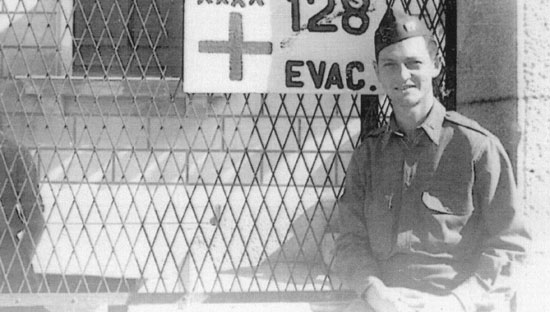
Captain Leonard Schwade standing in front of the 128th Evacuation Hospital’s entrance.
Other Evacuation Hospitals landed respectively on :
24th Evac > 12 June 1944
5th Evac + 41st Evac > 13 June 1944
45th Evac + 67th Evac + 96th Evac > 16 June 1944
97th Evac > 17 June 1944
44th Evac > 19June 1944
2d Evac > 23 June 1944
The first night was spent in pup tents, with friendly planes overhead and enemy artillery fire going on night and day. As a result of difficulties in discharging cargo, no significant amount of medical supplies came ashore before 12 June. Supplies however soon increased both in volume and regularity and depots were set up in open fields short distances inland, such as Le Grand Chemin, behind Utah Beach. The 261st Medical Battalion, 1st Engineer Special Brigade, almost exclusively handled the seashore movement of casualties out of Normandy. Acting as a kind of holding unit after Field and Evacuation Hospitals opened, the Battalion funnelled patients to the 2d Naval Beach Battalion, which put them on LSTs and British Hospital Carriers for evacuation to England. While Field Hospitals proved more than equal to their task, the 400-bed Evacuation Hospitals found themselves consistently overburdened; the arrival of additional Evacuation Hospitals helped contain the flow of patients, but in many cases a chronic surgical backlog persisted. During its first two weeks in Normandy, all but 360 out of 3,200 patients treated at the 128th Evac required surgery. Surgical staff worked in 12-hour shifts, although reinforced by extra Auxiliary Surgical Teams, and together they could perform about 100 major operations every 24-hours. The trouble was that the patient influx during heavy combat occurred at about double that rate, so that less urgent cases had to wait for surgery! First Army deployed extra Surgical Teams and mobile truck-mounted Surgical and X-Ray units (mounted on modified 2 ½-Ton Cargo Trucks) of the 3d Auxiliary Surgical Group, and detached provisional medical teams from ComZ Hospitals to help overcome the backlog!
By 2 July hospital personnel began to care for German PWs after the German surrender of Cherbourg, where all organized resistance had ceased on 1 July. The German front was broken and on 19 July St-Lô was captured which would later become the starting point for General Patton’s thrust towards Avranches. After a week of rest and refitting, First Army launched a new Offensive, “Operation Cobra” in an effort to break the front. Following intense aerial bombing (with some bombing errors killing friendly troops), American Forces heavily attacked on 25 July and forced the enemy to withdraw. The members of the 128th found themselves packing and moving to La Forêt for three days. The constant move caused by Allied progress on the battlefront often resulted in change of plans and hasty improvisation, and this is where training proved its worth.
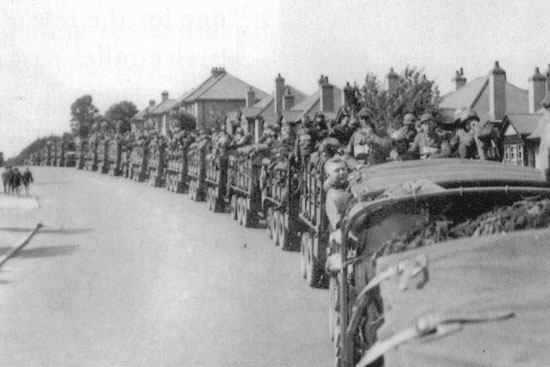
Personnel and equipment pertaining to the 128th Evacuation Hospital loaded into 2 ½-Ton Cargo Trucks in preparation for its movement to Belgium.
The Allied build-up continued during the months of July and August, and by then the Army could rely on medical support of 22 Evacuation and 6 Field Hospitals. By 1 August, they had treated and returned to duty over 23,000 patients and evacuated 56,000 wounded to England.
Colonel Norman H. Wiley received orders to move the 128th Evac Hosp on 15 August. A few miles south of Argentan, in the southern opening of the Falaise Pocket was the site of the hospital. Germans were trapped and the fighting in this area was fierce. US troops overran a number of German Aid Stations and Field Hospitals, and this sudden flow of enemy casualties temporarily overwhelmed and immobilized certain medical units in the rear. Later, Hospitals pressed captured German doctors and aidmen into service to help care for the prisoners. Preparing for the pursuit across the Seine River, First Army concentrated most Hospitals, Depots, and Medical Groups around Senonches, 50 miles southeast of the French Capital Paris. It also became an assembly place for Evacuation Hospitals and other less mobile medical units in order to facilitate communications and control. By 31 August, the unit was stopped at Senonches, going into bivouac for some welcome rest and recuperation and repair or replacement of its worn equipment. By 10 September they were on the road again, moving towards Belgium.
Operations in Belgium & Battle of the Bulge:
Belgium was reached 14 September 1944, and around 1 December the unit stood at the German border. Witnesses recall the typical fall weather, with lots of fog, clouds, and rain, resulting in muddy terrain difficult to move through. Material, such as wood, sacks, and branches were hauled to provide a passable and traversable way to allow ambulances to reach the wards.

Awarding of Bronze Star Medals to a number of ANC Officers, October 16, 1944. From Right to Left are Nurses: Gladys Martin, Ora White, Genevieve F. Kruzic and Amy L. Nickles.
Since 29 September, the battle for the German city of Aachen continued, in a frenzy until well into October. The 128th was able to watch the destruction from their current location and with the fall of Aachen, November brought lots of rain and new problems for the Hospital. With the steady rainfall pools began to form on top of the tents causing stress on the ropes and collapsing them.
In December the 128th Evacuation Hospital set up residence in Brandt, Germany in a German Army Post where it would begin service for a new battle raging in the Hürtgen Forest. 16 December 1944 brought much activity to the 128th, the Battle of the Bulge which raged into January 1945 bringing in its wake casualties, and much movement.
German paratroopers had been dropped only a few miles away from the 128th at Malmédy. The sound of anti-aircraft fire was consistent throughout the night. Trucks from the 128th were sent to Malmédy to move patients and hospitals to safer areas behind the lines, and on 23 December the 128th Evac moved to Verviers, with the Germans forces threatening them.
At 0800, 25 December, the 128th opened its doors at Verviers. That afternoon a Christmas Dinner was served to all personnel, including visitors from the 97th Evacuation Hospital, also located in this Belgian city.
After the move to Hannut, Belgium, on 24-25 January, the unit entrucked for Banneux on January 28 and opened for operations once again on 3 February 1945. The weather was warmer than normal and the patients were regular and manageable. On 26 February, Lt. Gladys (Martin) Flynn left the 128th. Only 17 of the original 60 Nurses who landed in North Africa on 8 November 1942 were still with the unit.
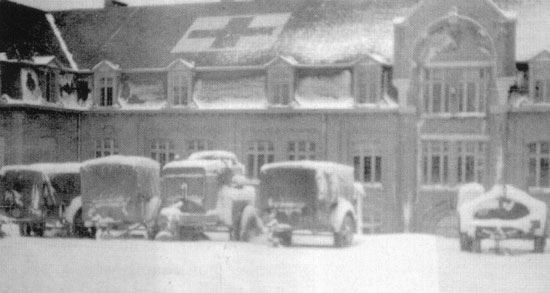
Illustration showing part of the 128th Evac Hospital’s Motor Pool and the complex which it occupied during the Unit’s time in Verviers, Belgium.
With the drive of the First United States Army across the Erft River toward the Rhine, a number of Evacuation Hospitals were moved to support operations. By 1 March, following Evacuation Hospitals opened in support of the troops, they comprised the 5th Evac – 44th Evac – 45th Evac – 96th Evac – 102d Evac – 103d Evac and the 128th Evac. On March 9, 1945 the 128th Evac Hosp trucked to Euskirchen, Germany in support of the Remagen Bridgehead. After nine days the unit was moved across the Rhine River to Dunstekoven, Germany and began operating under canvas again. On 28 March, the unit moved once more and opened at Ihrlich. Along with the 5th Evac and 67th Evac Hospitals, the 128th supported operations in the Ruhr Pocket.
American and Allied troops were now moving fast across Germany and the scenery that greeted the Hospital was some of the most beautiful they had ever seen, along however with mass destruction. Personnel were inwardly concerned about the possibility of being redeployed and sent to the Pacific now that things were winding down in Europe, but they were told that they would be going home, and many hoped it was true. It was spring once again and along with casualties hospital personnel were ravaged with mumps.
The 128th Evac Hosp was reorganized under T/O & E 8-581, 1944, effective 25 Mar 45, ref. AG 320.2 (31 Jul 43) PE-A-M-C, dated 20 Aug 43, CM IN 30713, European Theater of Operations, US Army (ETOUSA), 30 Jan 45 (dated 31 Jan 45).
On 14 April 1945 the Hospital was located at Krombach, Germany and it had moved two more times. At this point the organization was treating mostly PWs. On April 30, 1945 the 128th Evacuation Hospital moved for the last time to Grafenwohr, Germany, where it operated from 1-8 May 1945.
By May 1945, First Army controlled the following Evacuation Hospitals:
2d Evac – 5th Evac – 44th Evac – 45th Evac – 67th Evac – 96th Evac – 97th Evac –
102d Evac – 103d Evac – 118th Evac – 126th Evac – 128th Evac – 134th Evac Hospitals
The 128th started packing 26 – 27 November, leaving for France where it arrived 29 November 1945. It would spend another Christmas (the last one overseas) until embarking for the United States on 28 December 1945.
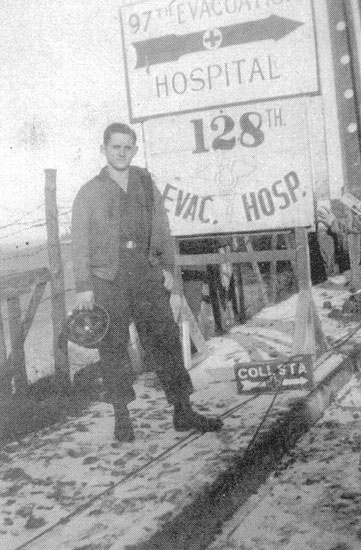
James F. Dick of the 128th Evac Hosp stands in front of signposts indicating the direction of both his own unit and the 97th Evacuation Hospital.
The Hospital was to transfer on a permanent change of station, with Shipment No. RE 7447-N and Det Shipment No. 7447-NA from the European Theater of Operations, US Army (ETOUSA) to the Continental United States. CM OUT 21720, dated 15 Nov 45, ref. Ltr. US Forces European Theater (USFET) 21 Nov 45. The unit departed France on the “George Goethals” 1 Jan 46. CM IN 51339 (3 Jan 46) and arrived 11 Jan 46 (Recapitulation Report dated 14 Jan 46).
The 128th Evacuation Hospital was to be inactivated, ref. AG 322 (16 Jul 45) OB-I-SPMOU-M, dated 21 Jul 45, and ref. AG 322 (28 Nov 45), and 1 Dec 45. Effective 12 Jan 46, at Cp. Kilmer, Stelton, New Jersey (Staging for NY POE), ref. GO No. 36, New York POE, dated 11 Jan 46.
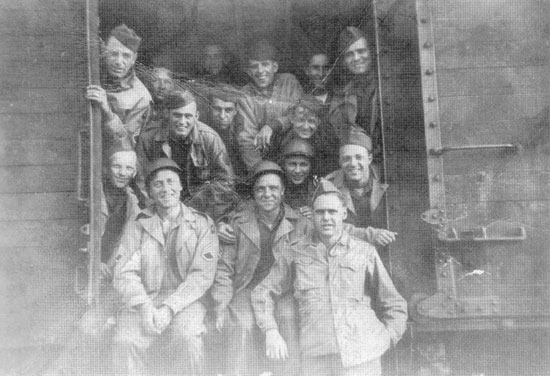
Members of the 128th Evacuation Hospital loaded into railcars for their return journey to the United States.
As the war in Europe was coming to a close the Army instituted the “Point System”. Each soldier was awarded points for time in service, time in combat, and other personal factors. Most of the members of the 128th were sent home between 1 July and 1 December 1945. They sailed and flew home on converted troop ships and bombers. The adjustment of returning home was tremendous and would require time and patience for the Veterans.
| STATIONS | |
| 10 Feb 41 > 30 Jul 42 | Zone of Interior, Ft. Francis E. Warren, Wyoming, USA |
| 02 Aug 42 > 02 Aug 42 | Indiantown Gap Military Reservation |
| 02 Aug 42 > 05 Aug 42 | New York Port of Embarkation, USS Wakefield (AP-21) |
| 18 Aug 42 > 21 Oct 42 | England, United Kingdom |
| 22 Oct 42 > 23 Oct 42 | Scotland, United Kingdom |
| 23 Oct 42 > 8 Nov 42 | Port of Embarkation, HMS Orbita |
| 09 Nov 42 > 17 Apr 43 | North Africa (Algeria, French Morocco) |
| 18 Apr 43 > 20 Jul 43 | Tunisia |
| 30 Jul 43 > 07 Nov 43 | Sicily |
| 08 Nov 43 > 23 Nov 4 | Aboard US Transport vessel (LST) |
| 26 Nov 43 > 07 Jun 44 | England, S/S William N. Pendleton (Liberty Ship) |
| 10 Jun 44 > 14 Sep 44 | France |
| 14 Sep 44 > 01 Dec 44 | Belgium |
| 01 Dec 44 > 23 Dec 44 | Germany |
| 23 Dec 44 > 09 Mar 45 | Belgium |
| 09 Mar 45 > 27 Nov 45 | Germany |
| 29 Nov 45 > 28 Dec 45 | France |
| 11 Jan 46 > 12 Jan 46 | Zone of Interior, Cp. Kilmer, New Jersey, USA |
| ASSIGNMENTS | |
| 13 Jan 41 | Fourth United States Army |
| 18 Aug 42 | European Theater of Operations |
| 09 Nov 42 | North African Theater of Operations |
| 15 Jan 43 | Fifth United States Army |
| 26 Nov 43 | European Theater of Operations |
| 11 Jan 45 | Third United States Army |
| 17 Jan 45 | Seventh United States Army |
| CAMPAIGN CREDITS | |
| 08 Nov 42 > 11 Nov 42 | Algeria, French Morocco (ref. WD GO No. 59, 1945) |
| 17 Nov 42 > 13 May 43 | Tunisia (ref. WD GO No. 59, 1945) |
| 09 Jul 43 > 17 Aug 43 | Sicily (ref. WD GO No. 91, 1945) |
| 06 Jun 44 > 24 Jul 44 | Normandy (ref. WD GO No. 102, 1945) |
| 25 Jul 44 > 14 Sep 44 | Northern France (ref. WD GO No. 103, 1945) |
| 16 Dec 44 > 25 Jan 45 | Ardennes-Alsace (ref. WD GO No. 114, 1945) |
| 22 Mar 45 > 11 May 45 | Central Europe (ref. WD GO No. 116, 1945) |
| BATTLE AWARDS | |
| 08 Nov 42 > 10 Nov 42 | Bronze Arrowhead, Amphibious Assault & Landing North Africa (ref. WD GO No. 70, 1945) |
Above Unit History was gratefully received from Lisa Merzke. Lisa shared some of her inputs and photographs received from Veterans who served with the Hospital in WW2, while the authors added a number of historic facts and data. For those interested in subject History and the ANC, Lisa runs a separate website dealing with the 48th Surg / 128th Evac Hospital – www.48th128th.com.
